Ten Years of Reliability Your Trusted Partner
CONTEXT
1. What is a detachable gooseneck lowboy trailer?
2. What is the difference between a lowbed and a detachable lowboy trailer?
3. How does a detachable gooseneck lowboy trailer work?
4. How much weight can a detachable gooseneck lowboy hold?
5. What are the characteristics of a detachable gooseneck trailer?
6. What is a detachable gooseneck lowboy load?
7.How long is a detachable gooseneck lowboy trailer?
In the realm of heavy-duty transportation, detachable gooseneck lowboy trailers have revolutionized the way oversized and overweight cargo is transported. These specialized trailers offer unique advantages, making them indispensable in various industries such as construction, mining, and oil and gas.
A detachable gooseneck lowboy trailer, also known as an RGN (Removable Gooseneck) trailer, is a type of heavy-haul trailer designed to transport large, heavy, and often oversized equipment and machinery. Unlike traditional trailers, the gooseneck on an RGN can be detached from the main trailer, allowing for easy loading and unloading of cargo. This detachable feature is particularly useful when dealing with self-propelled or wheeled machinery.
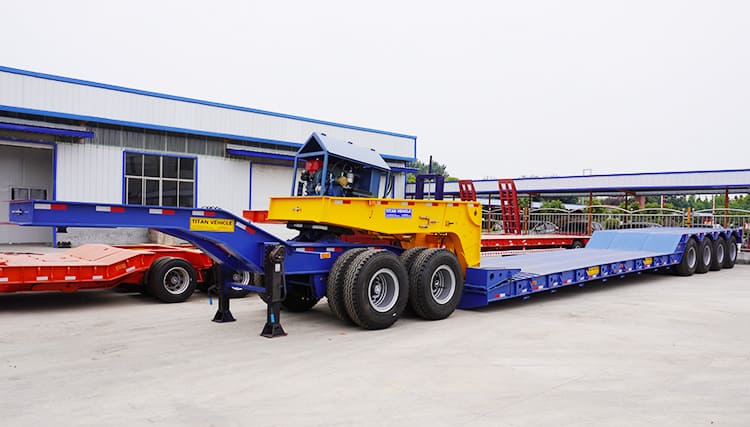
What is a detachable gooseneck lowboy trailer?
Advantages:
1. Accessibility: The detachable gooseneck feature enables easy access to load and unload equipment. By detaching the gooseneck, the trailer creates a ramp, providing a direct path for machinery to be driven on and off without the need for additional loading equipment.
2. Versatility: Detachable gooseneck lowboy trailers come in various configurations, including fixed neck, mechanical detachable neck, and hydraulic detachable neck. This versatility allows operators to choose the appropriate trailer based on their specific needs and cargo requirements.
3. Increased Payload: The lowboy design of these trailers ensures a lower deck height, which results in increased vertical clearance for taller cargo. This feature is particularly crucial when transporting oversized equipment, eliminating the need for costly and time-consuming dismantling procedures.
4.Cost Efficiency: Detachable gooseneck lowboy trailers offer long-term cost savings by reducing the need for additional equipment and labor during loading and unloading. With easier access and streamlined operations, time and resources can be optimized, resulting in improved efficiency and productivity.
Detachable gooseneck lowboy trailers have emerged as an essential asset in the heavy-duty transportation industry. Their versatility, accessibility, increased payload capacity, safety features, maneuverability, and cost efficiency make them an ideal choice for transporting oversized equipment and machinery. As industries continue to evolve and demand more efficient transportation solutions, detachable gooseneck lowboy trailers will undoubtedly play a vital role in meeting these challenges and ensuring the smooth and secure movement of heavy cargo.
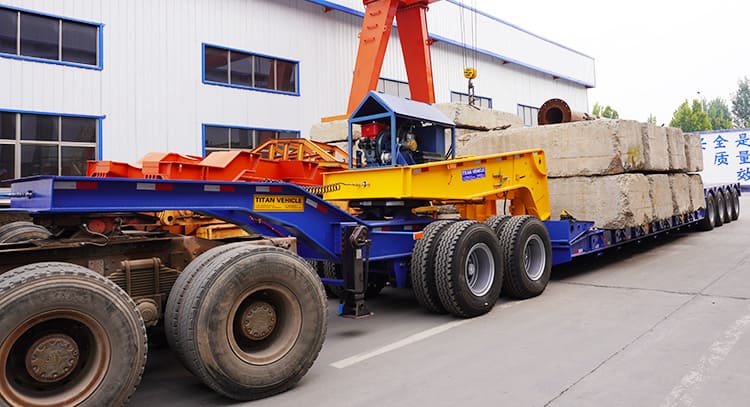
What is a detachable gooseneck lowboy trailer?
When it comes to heavy-duty transportation, it is crucial to choose the right trailer for the job. Two commonly used trailers in this realm are lowbed and detachable lowboy trailers. While these terms are often used interchangeably, there are distinct differences between the two. In this article, we will explore the disparities and shed light on what sets lowbed trailers apart from detachable lowboy trailers.
Lowbed Trailers:
Lowbed trailers, also known as lowboy trailers, are designed with a lower deck height compared to standard trailers. The primary purpose of a lowbed trailer is to transport tall cargo, such as construction machinery, vehicles, and large equipment. The deck of a lowbed trailer is typically a single, continuous level, extending from the front to the rear. This design allows for the easy loading and unloading of tall and heavy cargo from the front or rear of the trailer.
Detachable Lowboy Trailers:
On the other hand, detachable lowboy trailers, also referred to as RGN (Removable Gooseneck) trailers, offer a distinct advantage with their detachable gooseneck feature. These trailers consist of a detachable front section, known as the gooseneck, which can be separated from the main trailer. This detachable feature enables easy loading and unloading of cargo, particularly self-propelled or wheeled machinery.
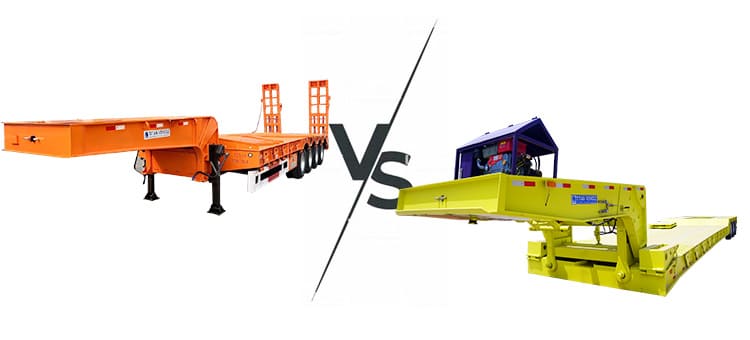
What is the difference between a lowbed and a detachable lowboy trailer
Key Differences:
1. Loading and Unloading: One of the fundamental differences between lowbed and detachable lowboy trailers lies in the loading and unloading process. Lowbed trailers are typically loaded or unloaded from the front or rear, whereas detachable lowboy trailers utilize the detachable gooseneck as a ramp, allowing for direct drive-on and drive-off access.
2. Flexibility: Detachable lowboy trailers offer greater flexibility when it comes to transporting oversized or tall cargo. The detachable gooseneck provides additional clearance for taller equipment, eliminating the need for time-consuming dismantling procedures. Lowbed trailers, while suitable for tall cargo, may require additional disassembly in some cases.
3. Maneuverability: Lowbed trailers and detachable lowboy trailers also differ in terms of maneuverability. Lowbed trailers have a fixed design with a continuous deck, which can limit maneuverability in certain situations. In contrast, detachable lowboy trailers offer enhanced maneuverability due to the ability to detach the gooseneck, allowing for improved weight distribution and better control during turns and navigating challenging terrain.
While lowbed and detachable lowboy trailers share similarities in their purpose of transporting heavy and oversized cargo, the key differences lie in their design and functionality. Lowbed trailers offer a lower deck height for taller cargo, while detachable lowboy trailers provide the advantage of a detachable gooseneck, allowing for easy loading and unloading of self-propelled machinery. Understanding these distinctions is crucial in selecting the appropriate trailer based on the specific requirements of the cargo and the transportation job at hand
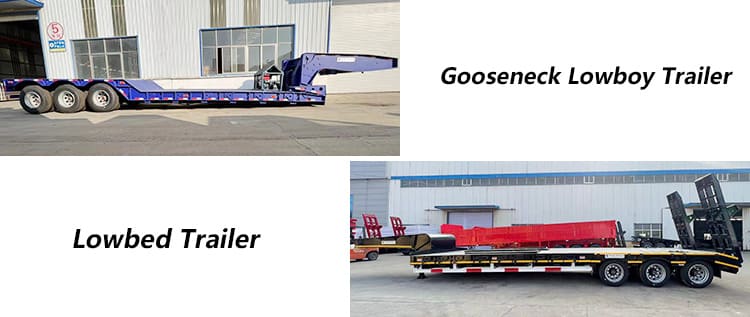
What is the difference between a lowbed and a detachable lowboy trailer
Detachable gooseneck lowboy trailers have gained significant popularity in the heavy-duty transportation industry due to their unique design and functionality. These trailers offer a detachable gooseneck feature that simplifies the loading and unloading of oversized and heavy cargo. In this article, we will explore the mechanics behind how a detachable gooseneck lowboy trailer works and how it streamlines the transportation process.
Detachable Gooseneck Mechanism:
The detachable gooseneck mechanism is the key element that sets this type of trailer apart from conventional trailers. The gooseneck is the front section of the trailer that connects to the truck or tractor unit. It can be detached from the main trailer, creating a ramp-like structure for convenient loading and unloading.
Loading Process:
1. Detachment: To initiate the loading process, the operator unlatches and disconnects the gooseneck from the trailer. This is usually done using hydraulic controls, which allow for smooth detachment.
2. Lowering the Gooseneck: After detachment, the gooseneck is lowered hydraulically until it reaches the ground. This creates a ramp that provides direct access for self-propelled machinery or wheeled cargo to drive onto the trailer deck.
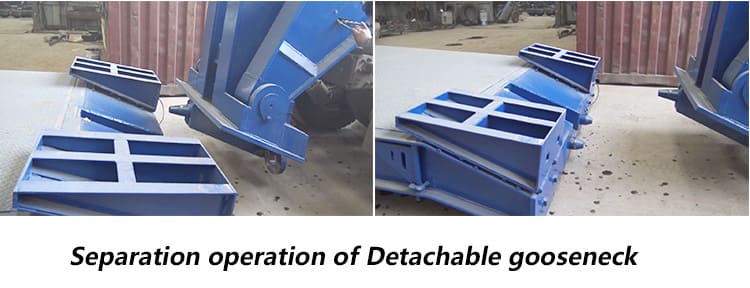
How does a detachable gooseneck lowboy trailer work?
3. Loading the Cargo: Once the gooseneck is lowered and the ramp is formed, the cargo, such as heavy machinery or equipment, can be driven or rolled onto the trailer deck. The low deck height of the trailer allows for easier loading of tall or oversized cargo.
4. Securing the Cargo: Once the cargo is on the trailer, it is securely fastened using chains, straps, or other appropriate methods to ensure stability and safety during transportation.
Unloading Process:
1. Unfastening and Preparation: Prior to unloading, the cargo is properly unfastened and prepared for removal.
2. Raising the Gooseneck: The hydraulic controls are used to raise the gooseneck back into a horizontal position. This eliminates the ramp and provides clearance for the cargo to be driven off the trailer.
3. Cargo Removal: With the gooseneck raised, the cargo can be driven or rolled off the trailer, either from the front or rear, depending on the design and configuration of the trailer.
4. Reattaching the Gooseneck: After the cargo is unloaded, the gooseneck is reattached to the trailer, ensuring a secure connection for the next transportation job.
Detachable gooseneck lowboy trailers simplify the transportation of oversized and heavy cargo through their innovative design. The detachable gooseneck mechanism, operated by hydraulic controls, allows for easy loading and unloading by transforming the gooseneck into a ramp. This streamlined process enhances efficiency, reduces the need for additional equipment, and ensures the safe transportation of valuable and often delicate cargo. Detachable gooseneck lowboy trailers continue to be a preferred choice for industries requiring heavy-duty transportation, such as construction, mining, and oil and gas
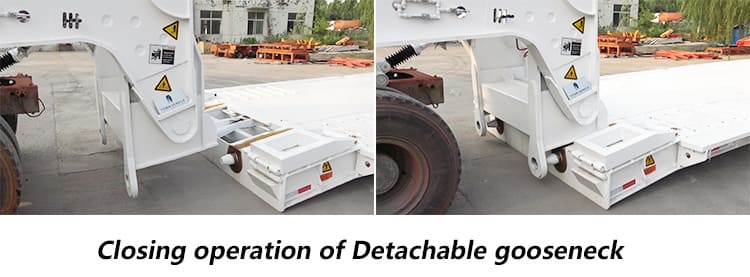
How does a detachable gooseneck lowboy trailer work?
When it comes to heavy-duty transportation, understanding the weight limitations of trailers is vital to ensuring safe and efficient operations. Detachable gooseneck lowboy trailers have become a popular choice due to their ability to transport oversized and heavy cargo. In this article, we will delve into the weight capacity of detachable gooseneck lowboy trailers and the factors that influence their load-bearing capabilities.
Weight Capacity:
The weight capacity of a detachable gooseneck lowboy trailer can vary based on several factors, including the trailer's design, structural strength, axle configuration, and regulatory guidelines. However, in general, detachable gooseneck lowboy trailers are capable of handling substantial loads.
Payload:
The payload capacity of detachable gooseneck lowboy trailers typically ranges from 40,000 pounds (18,000 kg) to 150,000 pounds (68,000 kg) or more, depending on the specific model and configuration. This capacity refers to the maximum weight of the cargo that can be safely transported on the trailer.
Axle Configurations:
The number of axles and their distribution across the trailer greatly influences the weight-carrying capacity. Detachable gooseneck lowboy trailers are available in various axle configurations, such as two axles, three axles, or even more. Trailers with additional axles are designed to distribute the weight evenly, increasing the overall load capacity.
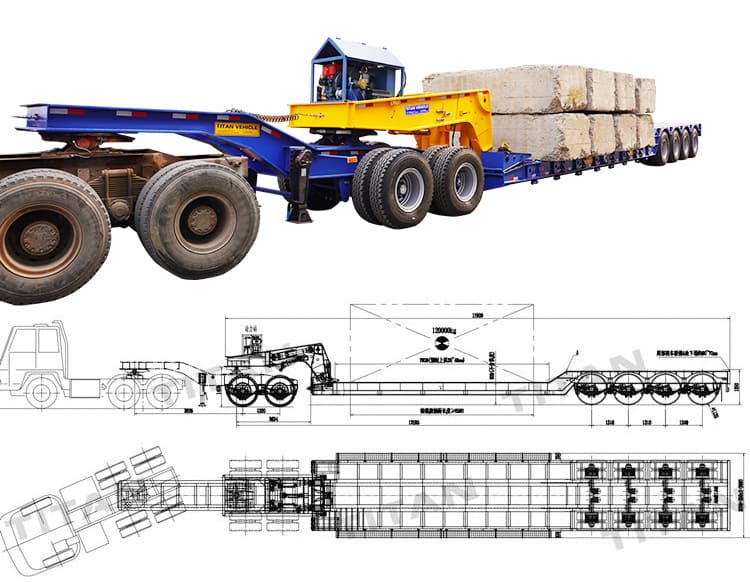
How much weight can a detachable gooseneck lowboy hold?
Legal Regulations:
It's important to note that weight limitations for trailers are subject to legal regulations imposed by local authorities. Different regions may have specific weight restrictions, including axle weight limits and overall gross vehicle weight restrictions. It is crucial to adhere to these regulations to ensure compliance and safety during transportation.
Considerations:
While detachable gooseneck lowboy trailers are designed to handle heavy loads, several considerations must be taken into account:
Load Distribution: Properly distributing the weight of the cargo on the trailer is essential for maintaining stability and ensuring safe transport. Uneven weight distribution can lead to imbalance, affecting handling and potentially causing accidents.
Road Conditions: The condition of the roads and the type of terrain that the trailer will traverse should be considered. Challenging terrains, such as steep inclines or uneven surfaces, may require additional precautions and potentially reduce the maximum weight capacity.
Equipment Compatibility: It is crucial to verify that the machinery or equipment being transported is within the weight limits of the detachable gooseneck lowboy trailer. Overloading can result in damage to the trailer, compromised safety, and potential legal repercussions.
Detachable gooseneck lowboy trailers exhibit impressive weight-carrying capabilities, making them a preferred choice for transporting heavy and oversized cargo. While weight capacity can vary based on trailer design, axle configuration, and legal regulations, these trailers are engineered to handle substantial loads. It is essential to understand and adhere to weight limitations, ensure proper load distribution, and comply with local regulations to maintain safe and efficient heavy-duty transportation operations.
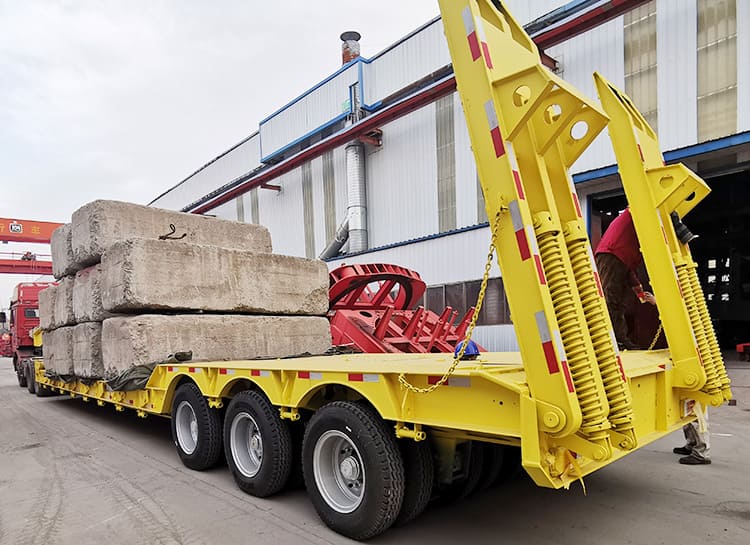
How much weight can a detachable gooseneck lowboy hold?
The defining characteristic of these trailers is the detachable gooseneck feature. The gooseneck, located at the front of the trailer, can be hydraulically detached, creating a ramp for convenient loading and unloading of cargo. This mechanism eliminates the need for additional loading equipment and streamlines the process, saving time and resources.
Versatility:
Detachable gooseneck trailers offer remarkable versatility. They come in various configurations, including fixed neck, mechanical detachable neck, and hydraulic detachable neck. This flexibility allows operators to choose the appropriate trailer based on their specific needs and cargo requirements.
Low Deck Height:
One notable characteristic of detachable gooseneck trailers is their low deck height. The deck sits closer to the ground compared to traditional trailers, providing additional vertical clearance for tall or oversized cargo. This feature eliminates the need for costly and time-consuming dismantling procedures, allowing for more efficient transportation of large machinery or equipment.
Enhanced Maneuverability:
Detachable gooseneck trailers offer improved maneuverability due to their design. The detachable gooseneck allows for better weight distribution between the truck and trailer, leading to increased stability and control during transportation. This characteristic is particularly advantageous when navigating tight turns, confined spaces, or uneven terrain.
Increased Payload Capacity:
These trailers are built to handle heavy loads. With sturdy construction and robust materials, detachable gooseneck trailers boast impressive payload capacities. They are capable of transporting substantial weights, making them ideal for industries such as construction, mining, and oil and gas.
Safety Features:
Detachable gooseneck trailers prioritize safety during loading and unloading operations. The detachable gooseneck acts as a ramp, eliminating the need for steep inclines or risky maneuvers. This design significantly reduces the risk of accidents or damage to cargo, ensuring a secure and smooth transportation process.
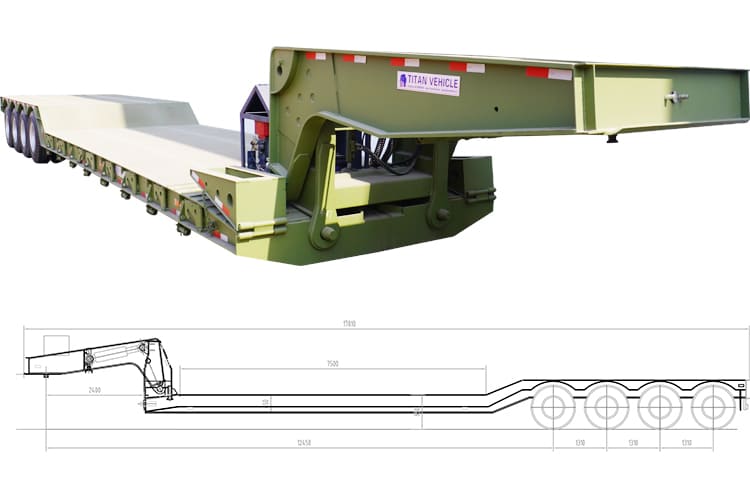
What are the characteristics of a detachable gooseneck trailer?
Versatility in Load Capacity:
Detachable gooseneck lowboy trailers are known for their exceptional load-carrying capabilities. They are designed to transport a diverse range of cargo, including:
Construction Machinery: These trailers are frequently utilized to transport construction machinery, such as excavators, bulldozers, loaders, cranes, and other heavy equipment. The low deck height and detachable gooseneck allow for easy loading and unloading of these machinery, ensuring efficient operations at construction sites.
Agricultural Equipment: Detachable gooseneck lowboy trailers are well-suited for transporting agricultural machinery and equipment. Tractors, harvesters, combines, and other farm implements can be securely loaded onto the trailer, thanks to its sturdy construction and appropriate weight distribution.
Industrial Machinery: Various industrial machinery, including generators, compressors, large pumps, and manufacturing equipment, can be safely transported using detachable gooseneck lowboy trailers. Their robust design and ample payload capacity ensure efficient and secure transportation of these vital components.
Oversized Structures: Detachable gooseneck lowboy trailers are also utilized for hauling oversized structures, such as prefabricated building components, large steel beams, wind turbine components, and other irregularly shaped loads. The low deck height and versatile configuration options enable the transportation of these bulky items with ease.
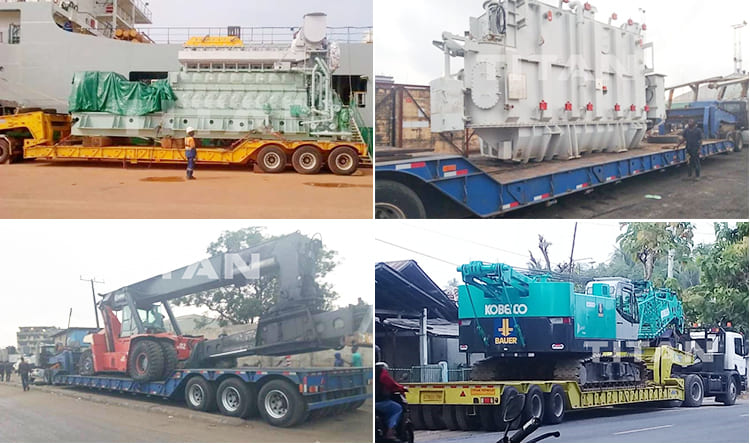
What is a detachable gooseneck lowboy load?
Benefits for Cargo Handling:
Detachable gooseneck lowboy trailers offer several benefits when it comes to cargo handling:
Convenient Loading and Unloading: The detachable gooseneck feature transforms the front section of the trailer into a ramp, simplifying the loading and unloading process. Cargo can be driven or rolled directly onto the trailer deck, eliminating the need for additional equipment or extensive disassembly.
Height Clearance: The low deck height of these trailers provides ample vertical clearance, making them suitable for transporting tall and oversized cargo. This characteristic eliminates the need for dismantling or modifying the load, reducing time and costs associated with preparation.
Secure Transportation: Detachable gooseneck lowboy trailers are designed with sturdy construction and appropriate tie-down points, ensuring secure transportation of heavy cargo. The ability to evenly distribute weight enhances stability and minimizes the risk of load shifting during transit.
Detachable gooseneck lowboy trailers offer a versatile and efficient solution for transporting various heavy and oversized loads. Whether it's construction machinery, agricultural equipment, industrial components, or oversized structures, these trailers provide the necessary features for secure and convenient cargo handling. Their versatility, low deck height, and detachable gooseneck mechanism make them an indispensable tool for industries requiring reliable and efficient transportation of heavy-duty loads
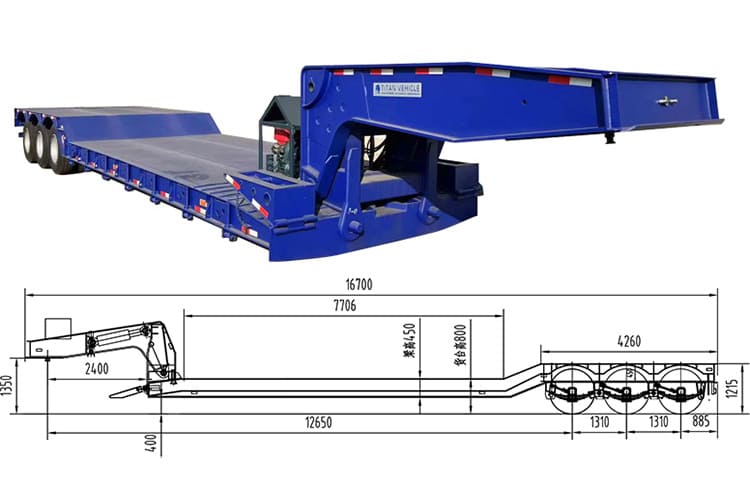
What is a detachable gooseneck lowboy load?
Detachable gooseneck lowboy trailers are designed to accommodate oversized and heavy cargo, providing a reliable transportation solution for various industries. Understanding the dimensions of these trailers is crucial for efficient operations and ensuring compatibility with different types of loads. In this article, we will explore the typical length of a detachable gooseneck lowboy trailer and its significance in heavy-duty transportation.
Trailer Length:
The length of detachable gooseneck lowboy trailers can vary depending on specific models and manufacturers. However, a common range for these trailers is between 40 feet (12 meters) and 53 feet (16 meters) in overall length.
Optimal Length Considerations:
The length of the trailer plays a significant role in determining its maneuverability, weight distribution, and legal compliance. Here are some key considerations related to the length of detachable gooseneck lowboy trailers:
Maneuverability: A reasonable length ensures better maneuverability, allowing the trailer to navigate through tight turns, narrow roads, and congested areas with ease. It enables the driver to have better control over the trailer during transportation.
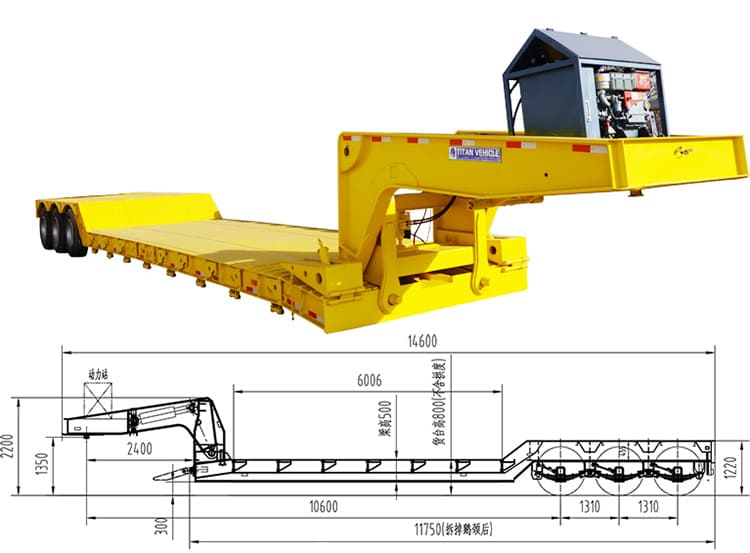
How long is a detachable gooseneck lowboy trailer
Weight Distribution: The length of the trailer impacts the weight distribution of the cargo. A properly distributed load helps maintain stability and balance, preventing excessive stress on the trailer axles and ensuring safer transportation.
Legal Compliance: Each region may have specific regulations regarding the maximum length allowed for trailers. It is essential to adhere to these regulations to ensure legal compliance and avoid any penalties or complications during transportation.
Cargo Compatibility: The length of the trailer should be suitable for the type and size of the cargo being transported. It is crucial to consider the dimensions and weight of the load to ensure it can be securely accommodated on the trailer without exceeding its capacity or compromising safety.